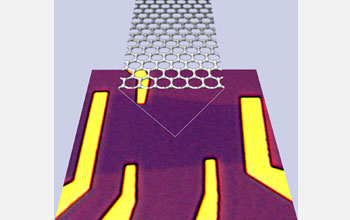News Release 08-048
Is Graphene the New Silicon?
Electrons travel through extremely thin form of graphite with little resistivity

Optical microscope image of the graphene device with material's lattice structure shown above it.
March 27, 2008
This material is available primarily for archival purposes. Telephone numbers or other contact information may be out of date; please see current contact information at media contacts.
Research results from University of Maryland physicists show that graphene, a new material that combines aspects of semiconductors and metals, could be a leading candidate to replace silicon in applications ranging from high-speed computer chips to biochemical sensors.
The research, funded by the National Science Foundation (NSF) and published online in the journal Nature Nanotechnolgy, reveals that graphene conducts electricity at room temperature with less intrinsic resistance than any other known material.
"Graphene is one of the materials being considered as a potential replacement of silicon for future computing," said NSF Program Manager Charles Ying. "The recent results obtained by the University of Maryland scientists provide directions to achieve high-electron speed in graphene near room temperature, which is critically important for practical applications."
Intrinsic resistance results from the unavoidable lattice vibrations in a material when the temperature is greater than absolute zero. The intrinsic resistance determines a material's mobility, or the speed at which an electrons move when an electric field is applied to the material. The very high mobility of graphene makes it promising for applications in which transistors must switch extremely fast, such as in the processing of extremely high frequency signals. If other extrinsic factors that limit mobility in graphene, such as impurities and lattice vibrations in the substrate on which graphene sits, could be eliminated, the intrinsic mobility in graphene would be higher than any other known material, and more than 100 times higher than silicon.
Graphene is also a very promising material for chemical and biochemical sensing applications in which an electrical signal from, for instance, a molecule adsorbed on the sensing device, is translated into an electrical signal by changing the conductivity of the device. The low resistivity and extremely thin nature of graphene also holds promise for applications in thin, mechanically tough, electrically conducting transparent films. Such films are sorely needed in a variety of electronics applications, from touch screens to photovoltaic cells.
Principal investigator Michael Fuhrer of the University of Maryland's Center for Nanophysics and Advanced Materials and the Maryland NanoCenter, said the electrical current in graphene is carried by only a few electrons moving much faster than the electrons in a metal like silver. "Our current samples of graphene are fairly 'dirty' due to some extraneous sources of resistivity," Fuhrer said. "Once we remove that dirt, graphene, at room temperature, should have about 35 percent less resistivity than silver, the lowest resistivity material known at room temperature."
-NSF-
Media Contacts
Diane Banegas, National Science Foundation, (703) 292-4489, email: dbanegas@nsf.gov
Lee Tune, University of Maryland, (301) 405-4679, email: ltune@accmail.umd.edu
Program Contacts
Charles Ying, National Science Foundation, (703) 292-8428, email: cying@nsf.gov
Sankar Basu, National Science Foundation, (703) 292-7843, email: sabasu@nsf.gov
Principal Investigators
Michael Fuhrer, University of Maryland, (301) 405-6143, email: mfuhrer@umd.edu
Related Websites
Small Grant for Exploratory Research (SGER) Award: http://www.nsf.gov/awardsearch/showAward.do?AwardNumber=0634321
University of Maryland news release: http://www.newsdesk.umd.edu/scitech/release.cfm?ArticleID=1621
The U.S. National Science Foundation propels the nation forward by advancing fundamental research in all fields of science and engineering. NSF supports research and people by providing facilities, instruments and funding to support their ingenuity and sustain the U.S. as a global leader in research and innovation. With a fiscal year 2023 budget of $9.5 billion, NSF funds reach all 50 states through grants to nearly 2,000 colleges, universities and institutions. Each year, NSF receives more than 40,000 competitive proposals and makes about 11,000 new awards. Those awards include support for cooperative research with industry, Arctic and Antarctic research and operations, and U.S. participation in international scientific efforts.
Connect with us online
NSF website: nsf.gov
NSF News: nsf.gov/news
For News Media: nsf.gov/news/newsroom
Statistics: nsf.gov/statistics/
Awards database: nsf.gov/awardsearch/
Follow us on social
Twitter: twitter.com/NSF
Facebook: facebook.com/US.NSF
Instagram: instagram.com/nsfgov


